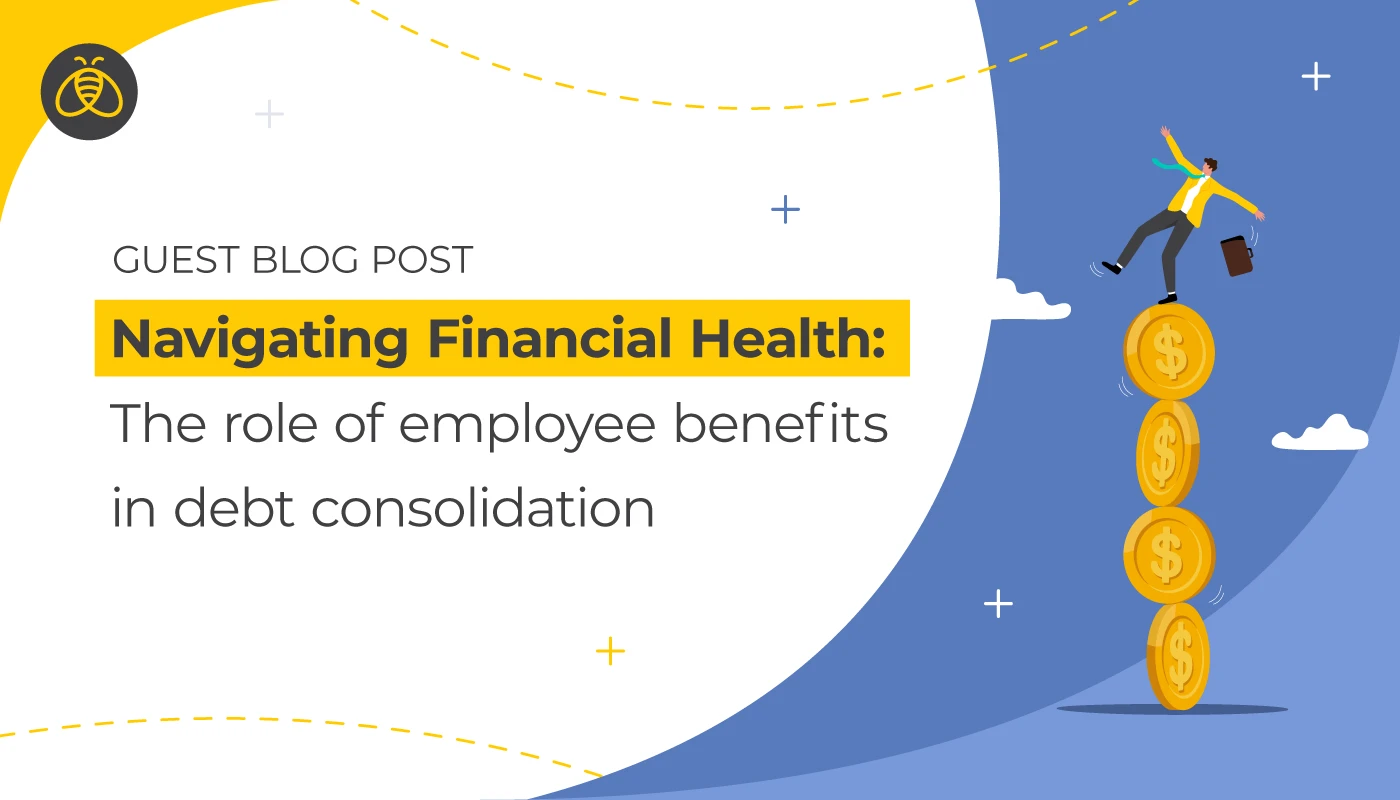Navigating Financial Health: The Role of Employee Benefits in Debt Consolidation
By: Benefits by Design | Tuesday January 9, 2024
Updated : Monday January 8, 2024
This is a guest blog post by Trevor Coulombe, a seasoned freelance writer dedicated to bridging the knowledge gap for business operators and individual creators.
In a realm where achieving financial balance can be a struggle, the astute use of employee benefits for debt consolidation stands as a beacon of strategic savvy. Often undervalued in their potential, these benefits can be coupled with powerful tools like a no-cost debt consolidation calculator to help pave the way for streamlined financial planning and adept navigation through the often tumultuous seas of debt. This exploration is not just about managing finances; it’s a journey towards transforming employee benefits into lifelines, redefining the way we approach and conquer our financial challenges.
Understanding Employee Benefits and Financial Wellness
Employee benefits that help employees financially can play a pivotal role in fiscal planning and debt navigation. When harnessed with acumen, these benefits can be pivotal in fortifying one’s financial health, offering more than just immediate monetary value.
The Spectrum of Employee Benefits
Employee benefits encompass a kaleidoscope, from health insurance to retirement plans and beyond. Each component can profoundly sculpt an employee’s financial terrain. Educational assistance programs might curtail or negate student loan needs, while legal assistance benefits could aid in negotiating debt terms. Wellness programs, employee assistance programs (EAPs) and preventative care through extended health and dental, can curtail healthcare expenditures, indirectly bolstering financial health.
Leveraging Benefits for Debt Management
Understanding and using these benefits can revolutionize financial management. Beyond retirement plan matching, there are a multitude of options employees can use. A health care spending account (HCSA) can be used to pay for monthly health and dental care premiums, reducing monthly costs and leaving more money in the employee’s pockets to help with debt repayment. HCSAs also offer tax-advantaged avenues for medical expenditures. Employer-sponsored life insurance policies, too, play a strategic role in fiscal planning, providing a bulwark against personal debt in unforeseen life events..
Maximizing Financial Gains through Tax-Advantaged Employee Benefits
Navigating the labyrinth of tax-advantaged employee benefits can unlock doors to fiscal growth and debt management. Here, we’ll unravel how leveraging these benefits can lead to significant financial gains, turning complex tax implications into opportunities for effective debt consolidation.
Tax Benefits and Debt Reduction
Employee benefits, often combined with tax breaks, can be a catalyst for savings. Traditional group RRSP contributions, made pre-tax, reduce taxable income, channeling savings towards debt repayment. HCSAs, with their tax-exempt status, enable efficient management of healthcare costs, sidestepping the need for high-interest loans.
Why You Should Offer a Group Retirement Solution (GRS) in Your Employee Benefits Plan
Disability benefits, critical illness insurance, and accidental death and dismemberment (AD&D) benefits add protection in case of illness or injury and provide employees with income while they recover. This can also reduce or negate the need for high-interest loans.
Employee Stock Options and Financial Leverage
Employee stock options, part of many compensation packages, offer financial leverage. When judiciously exercised, they can yield substantial returns, bolstering debt consolidation strategies and diminishing financial burdens.
Utilizing Employee Benefits for Long-term Financial Goals
Employee benefits should be seen not just as debt management tools but also as keystones for long-term financial aspirations. Employer-sponsored retirement plans, occasionally borrowable for debt consolidation, need cautious consideration, while life insurance policies might offer loan provisions or cash value components useful in fiscal planning.
Leveraging Educational and Professional Development Benefits
Employers often provide educational and professional development benefits, such as tuition reimbursement. Exploiting these opportunities can help employees augment their skill sets, paving the way for better employment prospects. With the heightened income potential., employees can strategically funnel this into debt repayment, hastening the march towards fiscal liberation.
Employee Benefits as a Tool for Debt Consolidation
Employee benefits, when wielded wisely, transform into powerful instruments for debt consolidation. This section delves into the art of utilizing these benefits as strategic tools, demonstrating how they can be channeled to streamline debt management and enhance financial freedom.
Identifying Opportunities for Consolidation
Scouring employee benefits for debt consolidation requires a meticulous assessment of available resources. Programs like tuition reimbursement can address education-related debts, while dependent care assistance can reduce family expenditures, liberating income for debt servicing.
Free Debt Consolidation Calculator: A Valuable Resource
Employee benefits can be used in tandem with a free debt consolidation calculator to illuminate a path to debt amalgamation and reduction. It provides more than mere calculations, offering insights towards debt reduction. By inputting varied debts, each with its unique interest rate and payment terms, this calculator paints a vivid picture of potential savings and more manageable repayment trajectories. In scenarios where debts are a multi-headed hydra, each head snarling with a different interest rate, this calculator becomes a financial Heracles, providing clarity and strategy to tame the beast.
Practical Steps to Utilize Employee Benefits in Debt Consolidation
Embarking on the journey of debt consolidation using employee benefits requires a pragmatic and informed approach. This part of the exploration provides practical steps to effectively harness these benefits, paving the way toward a more stable and debt-free financial future.
Evaluating Personal Debt Situation
The journey towards financial health through debt consolidation begins with an introspective audit of one’s debt landscape. This crucial step involves a meticulous assessment, not just of the numbers but the stories behind them. Each debt carries a narrative, whether it’s a student loan whispering tales of a future bright with education or a credit card debt echoing past expenditures. Understanding these narratives and their impact on one’s financial tapestry is vital. Identifying the urgency of each debt, based on interest rates and balances, lays the foundation for an effective consolidation strategy.
Consulting with Financial Advisors
Dialogue with financial advisors or employee benefits consultants transforms the journey of debt consolidation. These sages of finance offer not just advice but tailored strategies that consider the mosaic of individual circumstances against the backdrop of available employee benefits. Their guidance can weave resources like Employee Stock Purchase Plans (ESPPs) into a tapestry of debt management, ensuring that each thread strengthens the overall fiscal picture. This consultative process is about harmonizing the utilization of employee benefits with personal financial goals, ensuring that the path to debt consolidation is one that leads to future prosperity, not just present relief.
Empowering Financial Decisions Through Employee Benefits
Employee benefits are a formidable tool in the armory of financial wellness and debt management. Understanding and harnessing these benefits, coupled with tools like a free debt consolidation calculator, can markedly influence an individual’s trajectory towards financial stability. It’s about informed decisions, leveraging available resources, and proactive steps in managing and consolidating debt, that lead not only to enhanced financial health but also to augmented overall well-being and job satisfaction. Remember, the odyssey to financial health is perpetual, and employing every resource at your disposal, including your employee benefits, is paramount in successfully navigating this journey.

